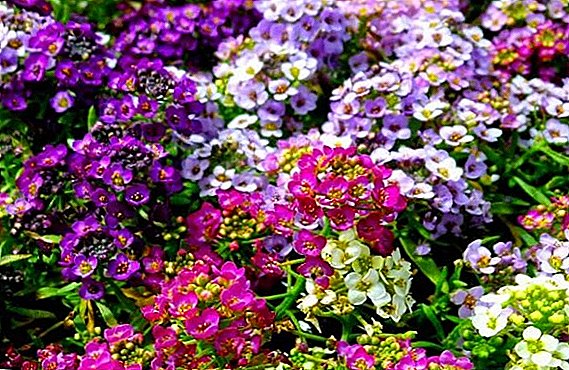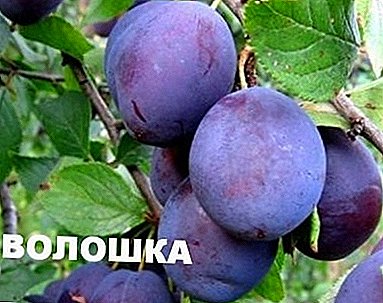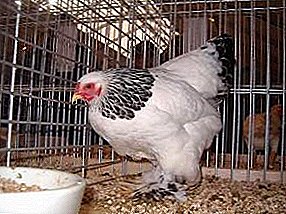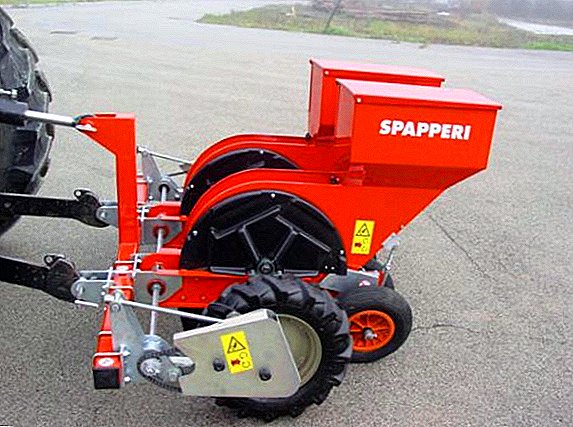 Calcium nitrate is quite often used in agriculture as a top dressing of flower plants, vegetables and fruit crops. In this article we will talk about the useful qualities of calcium nitrate, as well as consider a brief instruction on its use.
Calcium nitrate is quite often used in agriculture as a top dressing of flower plants, vegetables and fruit crops. In this article we will talk about the useful qualities of calcium nitrate, as well as consider a brief instruction on its use.
Calcium nitrate: fertilizer composition
As part of the fertilizer is directly calcium, which occupies about 19% of the total number of elements. Also present in the nitrate form is nitrogen - about 13-16%. This drug is marketed in the form of white crystals or granules.
It is very well soluble in water, has a high level of hygroscopicity. A nice addition is that the properties of this product can be maintained for quite a long time if it is stored in hermetically sealed packaging.
The name "saltpeter" comes from late Latin. It includes the words "sal" (salt) and "nitri" (alkali). 
Did you know? This compound, among other things, prevents corrosion of reinforcement, protects building materials from the effects of low temperatures, is used as an important component of explosives.
What is calcium nitrate for?
It has a rather positive effect on plants. Firstly, it is able to accelerate the process of photosynthesis, which rather quickly reflects on the general state of culture.
Also, the product helps to grow the green part and accelerates the growth of the plant as a whole, so that the crop can be obtained much earlier. Saltpeter works with the root system, provoking its active development. Applying it to the seeds, you can ensure their rapid germination.
In addition, this calcium product can make plants more resistant to diseases and pests. Treated garden and garden crops become more resistant to changes in air temperature.
The presentation of fruits becomes better, and their shelf life will be longer. According to observations, thanks to saltpeter, it is possible to increase the yield by 10-15%. 
Did you know? Calcium nitrate is used not only as a fertilizer for plants. It is also an additive for concrete, which can significantly increase its strength.
However, there is a drawback to this drug. If used incorrectly, it can have a detrimental effect on the plant's root system. In this regard, it is very important to adhere to the doses and timing of nitrate introduction into the soil, guided by the instructions.
When to make
According to the instructions for use, to apply fertilizer containing calcium nitrate in its composition, it is necessary only during the spring season when digging is carried out. It is not recommended to use the product in the autumn, as it is considered that there will simply be no effect from it.
This is based on the fact that nitrogen, which is a part of nitrate, during snow melting will be washed out of the soil, leaving only calcium there. The latter alone will not only benefit the plants, but may also have a detrimental effect.
Important! The most convenient way to use saltpeter in granules. It is easier to put in the soil and absorbs less moisture.
How to make
Saltpeter as a fertilizer in use is quite simple and straightforward. Top dressing can be root and foliar.
For root feeding
Very fond of calcium nitrate cabbage. But there are important points. Calcium nitrate for seedlings is useful, and you can feed it, adding the solution under the root. The solution itself is very simple to prepare, you only need to dilute 2 g of saltpeter in 1 liter of water.
But as far as adult cabbage is concerned, knowing that this crop does not like acidic soil, it is necessary to reach a compromise in a different way. Experienced gardeners decided this question in the following way: they introduce fertilizer granules not during digging into the soil, but directly into the hole for cabbage (1 tsp).
After that, you need to sprinkle the drug with a thin layer of earth and lower the plant root there. As a result, cabbage actively grows, accumulates leaves and, not least, does not undergo diseases.  As for other garden and garden crops, this type of fertilizer should be applied in the form of a liquid solution. Approximate dosages are as follows:
As for other garden and garden crops, this type of fertilizer should be applied in the form of a liquid solution. Approximate dosages are as follows:
- Strawberry. Top dressing is carried out exclusively before the flowering period. It will take on 10 liters of water 25 g of saltpeter.
- Vegetables that tolerate calcium. Introduce the drug before flowering, about 20 g dissolved in 10 liters of water.
- Fruit trees, shrubs. Feed before budding. You need to take 25-30 g of saltpeter per 10 liters of water.
Important! Calcium nitrate is well compatible with many types of fertilizers with the exception of simple superphosphate. Combining them is prohibited.
For foliar application
Foliar application is the sprinkling of plant crops. It contributes very well as a prophylactic against wilting of green parts, rotting of roots and fruits.
Such fertilizers are useful for cucumbers. Spray them for the first time after the third leaves appear on the stems. After that, observing the interval of 10 days, repeat the procedure before the stage of active fruiting. For foliar feeding cucumbers need 2 g of calcium nitrate and 1 liter of water.
For the same reason, calcium nitrate is popular in application for tomatoes. This should be done 7 days after planting seedlings in the ground. The drug will very well protect young growths from apical rot, slugs, ticks and thrips.  An interesting fact is that the calcium salt solution has the effect of accumulation and prolongation. This means that even after feeding is stopped, the bushes will maintain the power of immunity, and the tomatoes will remain protected from black rot.
An interesting fact is that the calcium salt solution has the effect of accumulation and prolongation. This means that even after feeding is stopped, the bushes will maintain the power of immunity, and the tomatoes will remain protected from black rot.
To prepare an effective working solution, you need to take 25 g of granulated product and dissolve it in 1 liter of water. Approximate consumption rates will be as follows:
- Vegetable and berry cultures. About 1-1.5 liters of solution will be spent per square meter.
- Flowers It will also take up to 1.5 liters of the liquid mixture.
- Shrubs. To process one bush, you need to prepare 1.5-2 liters of liquid fertilizer.
Important! The dosage is provided solely as a guide. Be sure to read the instructions before proceeding with the spraying of crops.
How to make yourself
If for some reason you cannot buy ready-made nitrate in a specialized store, then you can make it yourself. For this, ammonium nitrate and hydrated lime will be needed. Auxiliary items - a pan of aluminum, volume of 3 liters, bricks, firewood, water.
Hands and airways should be protected with gloves and a respirator. During the cooking process, a rather unpleasant odor will be emitted, therefore, such a procedure should be carried out only in an open space that is well ventilated. Preferably away from home.
First you need to make a mini-brazier of bricks. Laying out the wood, you should make a fire. In the pot you need to pour 0.5 liters of water and pour 300 g of ammonium nitrate to it. Put a pot (on the bricks) on a well-lit fire and bring the mixture to a boil.  When the water boils, you can slowly add lime. It is necessary to divide the introduction of lime into stages, each time pouring about 140 g of this substance. The whole process takes about 25-30 minutes. Understand that nitrate is almost ready, it is possible by the fact that the mixture will no longer give off the smell of ammonia. The bonfire can then be put out.
When the water boils, you can slowly add lime. It is necessary to divide the introduction of lime into stages, each time pouring about 140 g of this substance. The whole process takes about 25-30 minutes. Understand that nitrate is almost ready, it is possible by the fact that the mixture will no longer give off the smell of ammonia. The bonfire can then be put out.
Also as a fertilizer you can use various types of manure: horse, cow, sheep, rabbit, pig.
After a while, dark lime will settle in the pan. Then you need to take another container and drain into it from the first clean liquid, leaving the sediment intact at the bottom.
This liquid is called the mother solution of calcium nitrate. Just this solution will have to be applied to the soil or applied with the purpose of spraying.
Calcium nitrate has become a reliable assistant to farmers. It fights well against diseases that may occur due to a lack of calcium. As for financial expenses, they will justify themselves in the first season.












